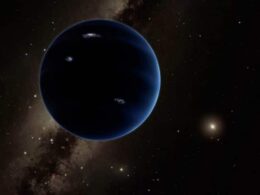Meteors can appear at any time on any night of the year. We see most when a meteor shower is active. But other meteors also randomly appear which cannot be identified with a known shower, and these are known as sporadic meteors, or simply sporadics.
Sporadic meteors are not always entirely random, however. For intriguingly, along with the several recorded streams of comet dust that Earth crosses as it orbits the Sun, there is another, admittedly weak, source of meteors in the night sky.
Throughout the year, these “shooting stars” appear to radiate from a region that is approximately, but not exactly, on the opposite side of the sky to the Sun (I’ll explain why later). For that reason it is known as the anthelion source (or sometimes, the anti-helion source). The word comes from “helios”. which is Greek for Sun.
This radiant does not lie in a fixed constellation, as for a short-lived shower such as the Perseids or Geminids. Instead, its position travels along the ecliptic – the plane of the Earth’s orbit – but always on that roughly opposite side of the sky to the Sun.
In June, when Sun is high in Gemini for northern hemisphere observers, the anthelion radiant is moving through the most southerly zodiacal constellations from night to night. But six months later, the positions of the Sun and the anthelion radiant have been reversed.
Unlike the fairly distinct radiants for the well-established meteor showers, the anthelion radiant is broad, with a diameter of around 20° which is 40 times the angular diameter of the Full Moon.
Related: Our guide to observing meteors
Related: How to photograph a meteor shower
When compared to one of the major showers, the idea of a constantly moving radiant for a source of some sporadic meteors can be difficult to get your head around. So here is how I think it can be pictured.
Imagine that you are on a long, fairly straight road, that is just gently curving to the left. Your car represents the Earth, and the road is its orbit around the Sun. Far to your left lies the Sun. Now imagine that constantly on your drive, you are being battered from your right by particles which are arriving from far away to your right (deep space) on their journey towards the Sun.
These particles represent the dust shed from comets plus some Earth-crossing asteroids, and they are travelling on their own elliptical orbits around the Sun. So why do they constantly arrive from your right for the whole of your orbital drive around the Sun?
The answer is that these dust particles are not just from a few dust streams. They are the final remains of countless comets, long lost, which continue to orbit the Sun from all directions. Wherever we are in Earth’s orbit around the Sun, we are crossing some streams from an ancient comet, brushing against us as they head sunwards.
Research has shown that these streams of dust are from short-period comets, In other words, comets that had orbits lasting only a few years. Originally they would have entered the inner Solar System from its icy outer reaches, from either the Kuiper belt, beyond Pluto, or the Oort Cloud, a vast reservoir of icy material much further away.
But the powerful gravitational pull of mighty planet Jupiter captured them into much smaller orbits, changing their orbital periods from thousands of years to just tens of years or even less. One short-period comet that we still see is Comet Encke, which takes just 3.3 years to orbit the Sun. It is the shortest-period comet that is known.
As mentioned earlier, the anthelion radiant does not lie exactly opposite the Sun in the sky. Instead it lies about 15° east of that point. This is due to the motion of the Earth around the Sun, and the effect is termed “apex attraction”. The radiant rises above one’s local horizon at sunset and is highest in the sky at around 1am local time. Meteors from the source appear to travel moderately fast at around 30km per second, due to the angle at which they strike the Earth.
Anthelion meteor rates are very low, at around five per hour for most of the year, so for most of us it is not worth sitting out on a special observing session to watch for them. However it is interesting, if you do catch a sporadic meteor, to trace its path backwards to see if it did indeed come from the direction of the anthelion radiant. The radiant is also a source of many fireballs throughout the year.
Meteors from these ancient comet dust streams will also be constantly striking us from the direction of the Sun, on the parts of their elliptical orbits that send them back out into deep space. However, these “helion radiant” meteors are not visible to us since the source lies in the same region of sky as the Sun. Meteors only occur when their radiant is above the horizon, so any from the general direction of the Sun streak through our skies in daylight.
Some weak sporadic meteor activity is also detectable from other regions of the sky, including obscure broad radiants known as the Northern Apex, Southern Apex, Northern Toroidal, and Southern Toroidal sources. You can read about them here.
Related: The night sky this month

